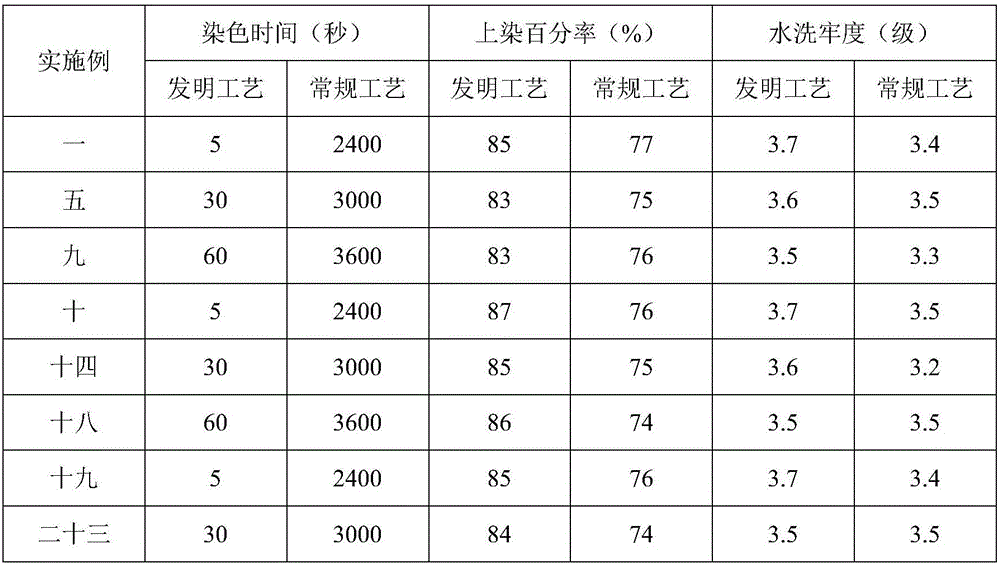Active dye quick salt-free dyeing method of cellulose product
A reactive dye, salt-free dyeing technology, applied in the field of textile printing and dyeing, can solve the problems of long dyeing and dyeing time of reactive dyes, not easy to add organic solvent in batches, and dyeing for a long time with reactive dyes, so as to shorten dyeing time and reduce dyeing. Cost and effect of reducing labor intensity
- Summary
- Abstract
- Description
- Claims
- Application Information
AI Technical Summary
Problems solved by technology
Method used
Image
Examples
Embodiment 1
[0030]According to the above process steps: the object to be dyed is cotton loose fiber, its quality is 1g, take 0.001g of reactive red B-3BF dyestuff, dissolve it in 0.75mL water to form the aqueous solution of dyestuff, then add 0.75mL ethanol to the aqueous solution and mix evenly, Finally, add 13.5mL of carbon tetrachloride and mix evenly to form a dyeing liquor. The volume of the dyeing liquor is 15mL. The cotton loose fibers to be dyed are immersed in the dyeing liquor for dyeing. The dyeing time is 5 seconds and the dyeing temperature is 25°C. After the dyeing is completed, take out the dyed cotton loose fibers for subsequent color fixing and washing processes. The washing temperature is 100° C. and the washing time is 15 minutes.
Embodiment 2
[0032] According to the above-mentioned process steps: the thing to be dyed is cotton loose fiber, its quality is 1g, take reactive yellow K-6G dyestuff 0.05g, be dissolved in 2.25mL water and form the aqueous solution of dyestuff, then add the ethanol of 5.25mL in the aqueous solution and mix evenly, Finally, add 22.5mL of carbon tetrachloride and mix evenly to form a dye liquor. The volume of the dye liquor is 30mL. The cotton loose fibers to be dyed are dipped in the dye liquor for dyeing. The dyeing time is 30 seconds and the dyeing temperature is 25°C. After the dyeing is completed, take out the dyed cotton loose fibers for subsequent color fixing and washing processes. The washing temperature is 100° C. and the washing time is 15 minutes.
Embodiment 3
[0034] According to the above process steps: the material to be dyed is cotton loose fiber, its mass is 1g, weigh 0.1g of reactive blue KE-R dye, dissolve it in 5mL water to form an aqueous solution of dye, then add 15mL ethanol to the aqueous solution and mix evenly, and finally add Mix 30mL of carbon tetrachloride evenly to form a dye liquor. The volume of the dye liquor is 50mL. The cotton loose fibers to be dyed are dipped in the dye liquor for dyeing. The dyeing time is 60 seconds and the dyeing temperature is 25°C. After the dyeing is completed, take out the dyed cotton loose fibers for subsequent color fixing and washing processes. The washing temperature is 100° C. and the washing time is 15 minutes.
PUM
 Login to View More
Login to View More Abstract
Description
Claims
Application Information
 Login to View More
Login to View More - R&D
- Intellectual Property
- Life Sciences
- Materials
- Tech Scout
- Unparalleled Data Quality
- Higher Quality Content
- 60% Fewer Hallucinations
Browse by: Latest US Patents, China's latest patents, Technical Efficacy Thesaurus, Application Domain, Technology Topic, Popular Technical Reports.
© 2025 PatSnap. All rights reserved.Legal|Privacy policy|Modern Slavery Act Transparency Statement|Sitemap|About US| Contact US: help@patsnap.com

